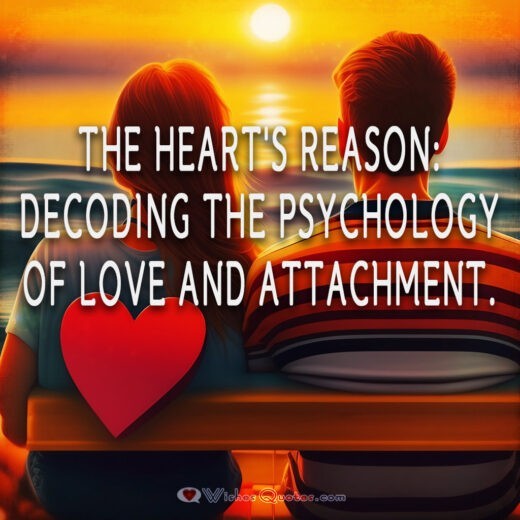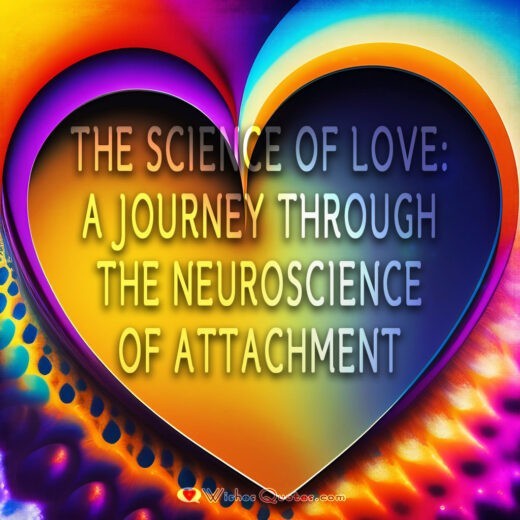The Heart’s Reason: Decoding the Psychology of Love and Attachment
A Love Story: Setting the Stage for Understanding
Love and attachment are two of the most powerful and enigmatic emotions that we, as human beings, experience. These emotions play a critical role in shaping our relationships, and they often shape the very fabric of our lives. From the joys of falling in love to the pain of heartbreak, love and attachment are complex and multifaceted experiences that challenge even the most astute observers. The study of love and attachment is not a new one. For centuries, philosophers, psychologists, and neuroscientists have sought to understand these emotions and how they impact our lives. But despite the vast amount of research that has been done, there is still much that remains unknown about the psychology behind love and attachment.
In this article, we aim to shed some light on this fascinating topic by exploring the various dimensions of love and attachment. We will examine the historical and cultural contexts that shape these emotions, the role of biology, evolution, and culture in their development, and the psychological and neurobiological underpinnings of love and attachment. Additionally, we will discuss the implications of our understanding of these emotions for our relationships, mental health, and well-being. So, whether you’re a seasoned expert on the topic or just starting your journey, this article aims to provide a comprehensive overview of the psychology behind love and attachment. Get ready to delve into the intricacies of the human heart and mind!
The Evolution of Affection: Tracing the Roots of Love and Attachment
- Love and attachment have been central to human experience for thousands of years, and they have evolved in many ways over time. From the ancient Greeks’ idealization of romantic love to the contemporary concept of polyamory, our understanding of love and attachment has been shaped by historical and cultural contexts.
- In many ancient cultures, love and attachment were often seen as divine and sacred, with gods and goddesses being invoked to bless and protect relationships. In these cultures, love was often associated with power, status, and wealth, and it was often seen as a way to cement alliances and strengthen families.
- As time went on, the idea of romantic love evolved, and it became more associated with personal fulfillment and individual happiness. The idea of “finding one’s soulmate” became increasingly popular, and love was seen as a way to find happiness and meaning in life.
- In recent times, love and attachment have continued to evolve, with new forms of relationships emerging and new norms and values shaping our understanding of these emotions. The rise of polyamory, for example, has challenged traditional notions of love and attachment, and it has opened up new avenues for exploration and expression.
- The evolution of love and attachment is also shaped by biology, evolution, and culture. From an evolutionary perspective, love and attachment are seen as survival mechanisms that help us form strong bonds and ensure the survival of our offspring. From a cultural perspective, love and attachment are shaped by societal norms and values, with different cultures having different expectations and attitudes towards these emotions.
- In this section, we will explore the various historical and cultural contexts that have shaped our understanding of love and attachment, and we will examine the role that biology, evolution, and culture play in the development of these emotions.
The Heart of the Matter: Exploring the Psychology of Love
- Love is a complex emotion that encompasses a range of feelings, including affection, desire, commitment, and intimacy. When we fall in love, our brains release chemicals such as dopamine, oxytocin, and adrenaline, which create feelings of euphoria, attachment, and excitement.
- There are many theories about the psychology of love, but one of the most widely accepted is the triangular theory of love, developed by psychologist Robert Sternberg. According to this theory, love is composed of three key elements: intimacy, passion, and commitment. Intimacy refers to the emotional connection between partners, passion refers to the physical and sexual attraction between partners, and commitment refers to the decision to stay with a partner over the long term.
- Another important aspect of the psychology of love is attachment theory, which focuses on the emotional bond between partners. Attachment theory posits that early experiences with attachment figures, such as parents, shape our patterns of attachment in later relationships. Those with secure attachments tend to have positive and fulfilling relationships, while those with insecure attachments may struggle in relationships.
- Additionally, the psychology of love is also shaped by cultural, gender, and individual differences. For example, research has shown that gender can play a role in how people experience and express love, with men and women often having different emotional and behavioral styles.
- In this section, we will delve into the intricacies of the psychology of love, exploring the triangular theory of love, attachment theory, and the impact of cultural, gender, and individual differences on our experience of love. Get ready to dive deep into the science of love!
The Science of Love: A Journey Through the Neuroscience of Attachment
- The study of the brain and love has long been a fascinating topic for scientists and researchers. In recent years, advances in neuroscience have shed new light on the biology and chemistry of love and attachment.
- When we fall in love, our brains release a flood of chemicals, including dopamine, oxytocin, and adrenaline, which produce feelings of euphoria and attachment. These chemicals play a crucial role in creating the intense emotional and physical connection that we associate with love.
- Oxytocin, known as the “cuddle hormone,” is especially important in the formation of attachment. When people hug or touch each other, their brains release oxytocin, which strengthens the bond between partners. Research has also shown that oxytocin can improve communication and intimacy in relationships.
- The brain’s reward system, which is associated with pleasurable experiences like food, sex, and drugs, also plays a role in the experience of love. When people are in love, the release of dopamine in the brain creates feelings of intense pleasure and happiness. This reinforces the emotional and physical connection between partners, making love a powerful and rewarding experience.
- In addition to the role of these chemicals, imaging studies have also shown that specific regions of the brain, such as the ventral tegmental area and the caudate nucleus, are highly active when people are in love. These regions are also associated with motivation and reward, further emphasizing the pleasurable and rewarding aspects of love.
- In this section, we will explore the fascinating world of the neuroscience of love and attachment, delving into the role of hormones like oxytocin, dopamine, and adrenaline in creating emotional and physical connections between partners. Get ready to learn how the brain and body work together to create the experience of love!
Applications and Implications: Love’s Real-World Impact
- The study of the psychology and neuroscience of love and attachment has significant practical applications and implications. For example, a deeper understanding of these processes can help couples strengthen their relationships and improve communication. It can also help individuals understand why they may have difficulty forming attachments and suggest ways to overcome these challenges.
- In addition, the study of love and attachment has the potential to inform the development of treatments for mental health conditions such as depression and anxiety, which are often related to issues with attachment and relationships.
- Furthermore, a deeper understanding of the biology and chemistry of love and attachment can help us better understand the role of these processes in our lives, from our personal relationships to our broader social connections.
- In this section, we will explore the practical applications and implications of the psychology and neuroscience of love and attachment. From improving relationships to informing mental health treatment, get ready to discover the real-world impact of this fascinating field of study!
Love’s Lasting Legacy: Wrapping Up the Heart’s Reason
In conclusion, the study of the psychology and neuroscience of love and attachment offers a fascinating glimpse into the inner workings of our hearts and minds. From the evolution of these processes to the role of hormones and the brain, we have explored the many ways in which love and attachment shape our lives and relationships. With practical applications and implications for individuals, couples, and society as a whole, the study of love and attachment is more relevant and important than ever. Whether you are in a committed relationship or simply looking to better understand the role of love and attachment in your life, this field of study has much to offer.
So, what is the heart’s reason for love and attachment? Through exploring the evolution, psychology, and neuroscience of these processes, we have come to understand that love and attachment are complex and multifaceted, driven by a combination of biology, chemistry, and experience. In the end, love and attachment are a lasting legacy, shaping our lives and relationships in profound and enduring ways. So, the next time you find yourself lost in love, take a moment to reflect on the heart’s reason, and the many ways in which love and attachment shape our lives and relationships.
References
- Mark Fischetti (2011). Your Brain in Love. Scientific American,.
- Amir Levine, Rachel S. F. Heller (2011). What Attachment Theory Can Teach about Love and Relationships. Scientific American.
- Bowlby, J. (1969). Attachment and loss. Basic Books.
- Hatfield, E., & Rapson, R. L. (1993). Love, sex, and intimacy: Their psychology, biology, and history. HarperCollins.
- Tobias Esch 1, George B Stefano (2005) The Neurobiology of LoveThe Neurobiology of Love. PubMed®
- Hazan, C., & Shaver, P. (1987). Romantic love conceptualized as an attachment process. Journal of Personality and Social Psychology, 52(3), 511-524.
- Aron, A., & Aron, E. N. (1997). Self-expansion motivation and including other in the self. In Advances in experimental social psychology (Vol. 29, pp. 106-153). Academic Press.
Love’s Legacy: Read Further into the World of Relationships and Love
- Love, Relationship, and Zodiac Signs
- Unlock the Secrets to Loving Better: A Step-by-Step Guide
- The Connection Between Love and Happiness
- The Secrets to a Lasting Love in Marriage
- Understanding Love in Relationships: A Comprehensive Guide
- He Love Me? He Loves Me Not? 30 Love Signs 30 Ways to Tell
- 10 Romantic Ways to Express you Love
- Advantages of Self-Love in a Relationship
- The Power of Love Songs and their Impact on Relationships
- 50 Flirty Pick Up Lines and Messages to Text your Crush


